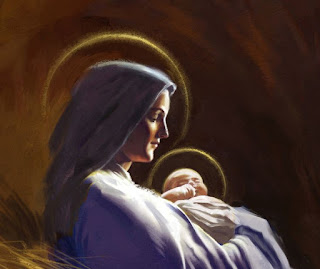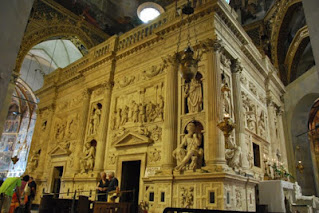STORY OF THE HOUSE OF THE VIRGIN MARY THAT DISAPPEARED AND APPEARED ELSEWHERE
THE HOUSE OF THE BLESSED VIRGIN MARY THAT DISAPPEARED AND APPEARED ELSEWHERE
The title "Our Lady of Loreto" is related to the Holy House of Loreto in Italy, the abode of the Holy Family of Jesus, Mary and Joseph, miraculously transported by the angels from Palestine to Europe.
The house of the Holy Family in Nazareth has always been the object of Christian veneration. Shortly after 313, Saint Helena, mother of the Emperor Constantine, built a Basilica over this holy House. The Saracens invaded the Holy Land in 1090, plundering and destroying Christian shrines, including Constantine’s Basilica. Under the ruble, the Holy House was found intact.
During the twelfth century, another Basilica was built to protect the holy dwelling. In 1219 or 1220 Saint Francis of Assisi visited the Holy House in Nazareth. So did King Saint Louis IX of France, when he was leading a crusade to liberate the Holy Land.
In 1263, when the Muslims conquered the crusaders, the Basilica was again destroyed but, once more, the Holy House was found untouched.
In 1291, when the crusaders were completely driven out of the Holy Land, the Holy House disappeared.
On May 10, 1291 a parish priest, Rev. Fr. Alexander Georgevich in the town of Tersatto, Dalmatia, (now Croatia) noticed the sudden appearance of a small building resting on a plot of land. Puzzled, he prayed about it, and in a dream saw the Blessed Virgin Mary, who explained that the structure was the house of the Holy Family, brought there by the power of God.
In 1294, when the Moslems invade Albania, the house disappeared again. According to the testimony of shepherds, it was seen on December 10 of the same year borne aloft by Angels over the Adriatic Sea. This time the Holy House came to rest in a wooden area four miles from Recanati, Italy. As the news spread, thousands flocked there, and many miracles took place at the site.
Due to contrary circumstances, twice again the house was moved, finally coming to rest in the town of Loreto, Italy, its present location.
As miracles continued to occur in connection with pilgrimages to the house, deputations were sent to Nazareth to determine its origins in 1292, in 1296, and in 1524. All three declared that the measurements of the house corresponded to the visible foundations of the house of Nazareth.
In 1871, Cardinal Bartolini suggested that materials be given to Professor Ratti of the University of Rome. Mortar and stones from the house at Loreto were given to him with similar materials from houses in Nazareth. Unable to identify which was which, Professor Ratti concluded that the composition of the material from the house of Loreto while not original to Italy was identical to that of the material from Nazareth.
Other striking facts about the house in Loreto are that:
- It has no foundations.
- The walls rest on a plot that was part field and part road, a sure indication that it was not built there but placed there.
- The style of the house of Loreto is not Italian but Eastern.
- The original door was on the long side of the house, indicating that it was a dwelling and not a church.
A great Basilica houses the dwelling of the holiest of families till date. From 1330, practically all the Popes have considered Loreto the greatest shrine of Christendom. Bulls in favour of the shrine were issued by Pope Sixtus IV in 1491 and by Julius II in 1507. While the miracle of the translation of the house is not a matter of faith, Innocent XII, in the seventeenth century, appointed a special Mass for the Feast of the Translation of the Holy House. Numerous saints have visited this house-relic.
There is an inscription on the threshold of the House, “Hic Verbum caro factum est” – “Here the Word became flesh”. Inside the holy house is an ancient statue of Our Lady holding the Infant Jesus above the altar, known as Our Lady of Loreto.






Post a Comment